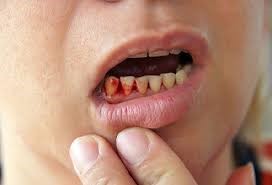It is common to see the third molars being the focus of an infection, whether visible or not.
- Wisdom teeth are more likely to become infected when they come out partially (semi-included) or completely in the mouth. Poor oral hygiene allowing the accumulation of dental plaque is an important cause of infection in the wisdom teeth region. The formation of tooth decay also contributes to the spread of infection in the tooth and its environment.

- When still under the gum (tooth included), a wisdom tooth can also become infected even in the absence of symptoms and therefore without the person being aware of it, especially at the early stage of infection.
THE MOST COMMON SIGNS OF INFECTION ARE:
o pain accompanied by other symptoms described below;
o swelling of the gum (swelling) or an abscess surrounding the tooth or that is located in the back of the mouth. The person may even sometimes have difficulty swallowing, be swollen near the eye or have a congested nose due to swelling in the gum;
o redness (inflammation) or localized feeling of heat near the tooth;
o presence of pus (suppuration) flowing near the tooth;
o persistent bad taste in the mouth or chronic bad breath (halitosis);
o feeling of pulsation in or near the affected tooth;
o swollen glands in the neck, when the person is not already suffering from another disease;
o fever not associated with any other disease.
It should be noted that if an infection associated with a wisdom tooth, or any other tooth, spreads, it can generate various symptoms far from the focus of infection and cause other symptoms. In the most severe cases, systemic problems can occur, such as a blood infection (bacteremia, sepsis, etc.) which can cause death.
o Any sign of infection in the mouth must therefore be taken seriously!
o The presence of a more or less large and painful bump in the mouth or visible on the face, either around a wisdom tooth which has erupted or which is included. Besides, it is not uncommon to see cysts or benign tumors around an included wisdom tooth.
o A pressure, throbbing or pulsating feeling near the ears, in the TMJ or jaw.
A pain in the cheeks , especially if the wisdom teeth grow so that their crown tip to the outside of the jaw and that irritates the inside of the cheek or there is the presence of swelling or a cyst on the side of the cheek.
o A limitation of mandibular opening , that is to say when a person has difficulty opening the mouth while he or she normally opened it or difficulty chewing, especially in the back of the mouth.
o A stiff jaw is often felt, as well as the inability to close the teeth completely together, while it was possible to do before.

